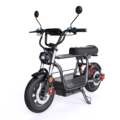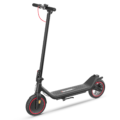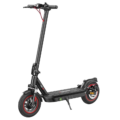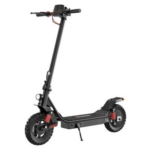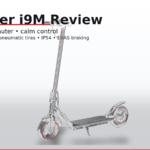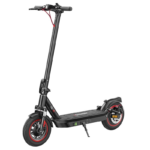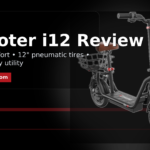- Home
- Scooters
- Electric Scooters
- iScooter i10 Plus
iScooter i10 Plus
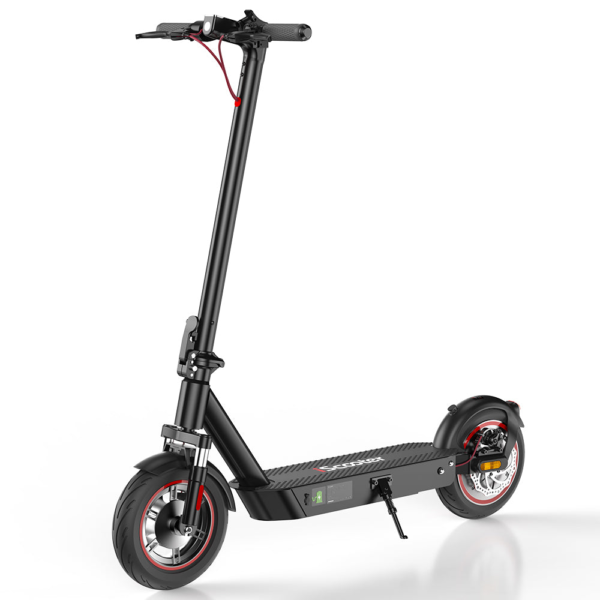

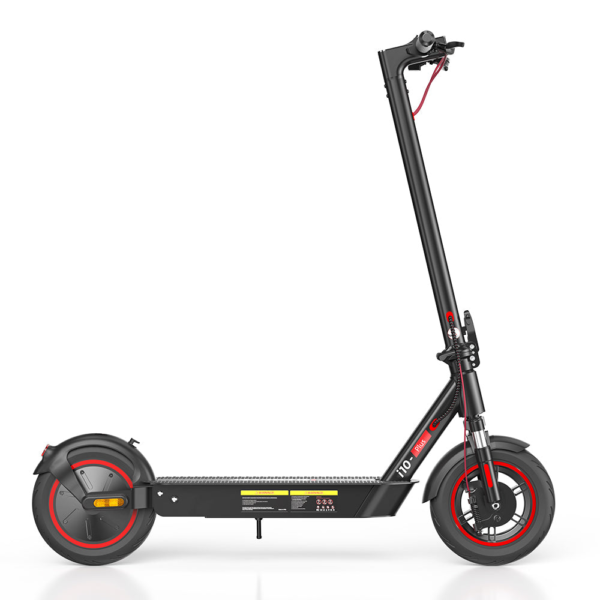
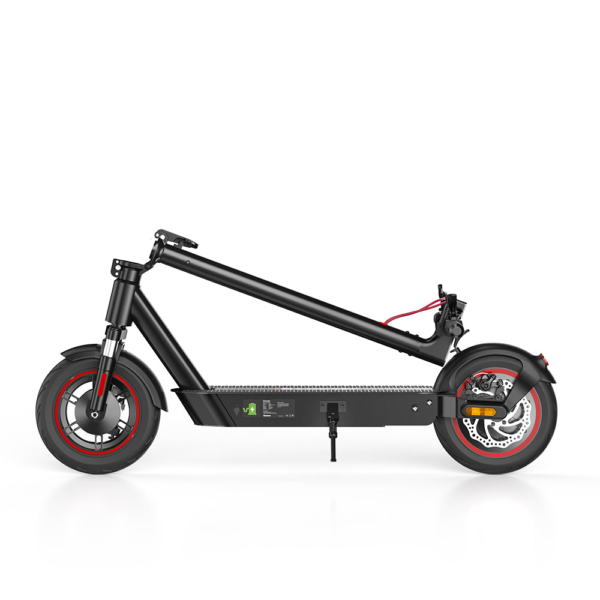
- Battery Range: 31 miles (50 km)
- Top Speed: 25 mph (40 km/h)
- Motor Power: 800 W peak rear hub
- Weight Capacity: 264.5 lb (120 kg)
- Charging Time: ~7–9 h
- Scooter Weight: 44.0 lb (20.0 kg)
PROS
- Higher-capacity 630 Wh battery
- Turn signals + full lighting
- RWD with 10″ pneumatics
- Dual suspension comfort
- IP54 water resistance
CONS
- Heavier than entry-level options
- Top speed capped at 25 mph
- Air tires need maintenance
- No height-adjustable stem


Table of contents
- What Is the iScooter i10 Plus?
- How the iScooter i10 Plus Works
- Key Specifications
- Design & Build Quality
- Performance Fundamentals
- Battery, Range & Efficiency
- Ride Quality & Comfort
- Braking & Safety Features
- Portability & Daily Usability
- Maintenance & Care
- Weather & Seasonal Considerations
- iScooter i10 Plus vs Alternatives
- Who the iScooter i10 Plus Is (and Isn’t) For
- FAQs
- Glossary
- Final Notes on Ownership
If you want a practical, sturdy, and comfortable commuter scooter that stays simple to use, the iScooter i10 Plus fits the brief. It blends a confidence-boosting ride with commuter-friendly range and a compact fold. Moreover, because it’s built around familiar parts and clear controls, it suits first-time riders as well as daily commuters who want a no-drama machine. For context, the sibling iScooter i10 shares a similar commuter focus, although the Plus version adds comfort and capability for longer rides.
What Is the iScooter i10 Plus?
The iScooter i10 Plus is a mid-class commuter e-scooter with a rear-hub motor, 10-inch pneumatic tires, dual spring suspension, and dual braking. It aims for a balanced mix of speed, range, and comfort rather than extreme performance. In practice, that means predictable acceleration, steady cruising on typical city streets, and a chassis that smooths out rough patches without demanding constant body adjustments. Consequently, daily rides feel calmer and less fatiguing.
It favors everyday practicality. The folding latch drops the stem quickly for stairs or car trunks. Additionally, the cockpit uses a clear LED display and a thumb throttle, so the controls feel natural within minutes. And because the tires are pneumatic, the scooter absorbs small bumps and seams that solid tires would pass to your hands and knees. As a result, you maintain better control across expansion joints, brickwork, and patched asphalt.
How the iScooter i10 Plus Works
Think of the scooter as a simple system with five key pieces working in sync. Taken together, they translate your thumb movements into smooth, confident motion.
Motor. A brushless rear-hub motor sits inside the back wheel. Press the throttle and the motor pulls current from the battery, turning electrical energy into rotation. Because the motor is in the wheel, there’s no chain or belt to align or maintain. Therefore, power delivery feels smooth and direct during starts and mid-corner roll-ons.
Controller. The controller is the scooter’s “brain.” It’s a small box that meters how much power goes to the motor—like a dimmer switch for a light, only quicker. When you roll the throttle, the controller decides how much current to send, keeping acceleration predictable and preventing harsh jerks. Consequently, new riders can settle into a pace without wrestling the scooter.
Battery. The battery is the fuel tank. Its voltage reflects the system’s electrical “pressure,” and its amp-hours show how much charge it holds. Larger watt-hours (volts × amp-hours) generally mean more range. The i10 Plus uses a commuter-sized pack that balances range with weight so the scooter remains portable. In turn, you get practical endurance without turning the fold into a heavy lift.
Throttle. The thumb throttle is your “gas pedal.” Press lightly for gentle roll-out. Press further for stronger pull. Because it’s thumb-operated, your hand stays stable over bumps and during turns. Consequently, steering inputs remain precise even when the road surface isn’t perfect.
Brakes. The braking system combines a mechanical rear disc with electronic braking. Mechanically, squeezing the lever pinches the rotor to cut speed. Electronically, the motor flips roles and resists rotation, like a magnet slowing a spinning disk. That “regen” effect adds a controlled, linear feel and reduces wear on the pads. In emergencies, this blend produces firm, confidence-building bite.
Key Specifications
Below are the official specifications for the model (both imperial and metric shown). For quick scanning, the information is grouped by category.
General
| Item | Detail |
|---|---|
| Class | Adult commuter electric scooter |
| Wheel Size & Type | 10 in pneumatic (25.4 cm) |
| Suspension | Dual springs: front & rear |
| Drive | Rear-wheel hub motor |
| Display | Multi-function LED |
| App | Bluetooth companion app (iOS/Android) |
Performance & Power
| Item | Detail |
|---|---|
| Top Speed | 25 mph (40 km/h) |
| Max Range (rated) | 31 miles (50 km) |
| Climbing Angle (rated) | 20% grade |
| Motor | Rear hub, up to 800 W |
| Ride Modes | 4 selectable modes |
Battery, Charging & Electrical
| Item | Detail |
|---|---|
| Battery Capacity | 36 V, 17.5 Ah (≈630 Wh) |
| Charger Output | 42 V, 2 A |
| Typical Charging Time | 7–9 hours |
| Electronics | LED lighting, turn signals, onboard display |
Build & Dimensions
| Item | Detail |
|---|---|
| Frame | Aluminum alloy |
| Unfolded Dimensions | 46.4 × 20.5 × 46.4 in (118 × 52 × 118 cm) |
| Folded Dimensions | 46.4 × 20.5 × 20.8 in (118 × 52 × 53 cm) |
| Net Weight | 44 lb (20 kg) |
| Handlebar Folding | No |
| Adjustable Stem | No |
| Max Rider Weight | 264 lb (120 kg) |
Safety & Control
| Item | Detail |
|---|---|
| Brakes | Front hub brake + electronic; rear mechanical disc + electronic |
| Lights | Front LED, rear LED brake light, turn signals |
| Reflectors | Yes |
| IP Rating | IP54 water-resistance |
Features & Extras
| Item | Detail |
|---|---|
| Cruise Control | Yes |
| Riding Modes | 4 |
| Mudguards | Front and rear |
| Bell / Horn | Bell |
| Kickstand | Yes |
Warranty & Compliance
| Item | Detail |
|---|---|
| Warranty | 12-month manufacturer warranty (typical, excludes wear items) |
| Regional Rules | Local e-scooter regulations vary by area |
Design & Build Quality
Frame and deck. The chassis uses aluminum alloy for a strong yet manageable structure. The deck offers enough length for a staggered stance—front foot angled, rear foot slightly across—so you can relax your hips and bend your knees over patchy pavement. Additionally, the deck mat grips shoes well when dry and remains serviceable when damp, though you should still step lightly on wet days.
Stem and latch. The stem feels stout for a commuter scooter in this weight class. Because the folding latch is a single-action design, it takes little effort to drop the stem for a train or car trunk. After a few rides, make a habit of checking latch tightness. Even well-made latches can loosen slightly as parts bed in; therefore, a periodic snug-up keeps the front end quiet.
Cockpit layout. The LED display sits at a quick-glance angle, so speed and battery are easy to read. The thumb throttle falls under the right thumb, which helps you ride smoothly over rough spots. Meanwhile, the brake lever sits left and offers a comfortable pull. Reflectors sit fore and aft for side-on visibility at night, and cabling routes cleanly to minimize snags.
Fit and finish. Panel gaps are tidy, fasteners line up, and cable routing is sensible. The front and rear spring modules mount close to the wheels, which reduces visual bulk and keeps the deck low for stable carving. In addition, the fenders hug the tires to block splash without rubbing when the suspension compresses. Altogether, the scooter looks cohesive and feels ready for daily duty.
Performance Fundamentals
Acceleration feel. From a standstill, the scooter eases into motion with a gentle initial push, then pulls more firmly as the motor loads. The controller’s mapping favors smooth roll-out, which helps new riders learn throttle finesse. In higher modes, mid-range punch is enough to clear short intersections without strain; however, it never turns abrupt or twitchy.
Cruising stability. At neighborhood speeds, the chassis tracks straight and resists quick wobble inputs. The 10-inch pneumatic tires add a layer of natural damping. As your speed rises, keep a light bend in your elbows and knees, and shift weight slightly forward over expansion joints. Consequently, the steering stays calm and the deck remains planted, even when the surface changes rapidly.
Hill-climb behavior. On moderate urban hills around 7–10% grade, expect speed to drop but progress to continue steadily. The rear-drive layout loads the motor during climbs for better traction. For long hills, choose a middle mode. You’ll reduce heat buildup while keeping enough pace to crest without a full stop. If a steep ramp forces a slow-down, take a short cool-down at the top before charging down the other side; that habit protects both controller and battery.
Battery, Range & Efficiency
Rated vs real-world. The rated pack capacity sits in the commuter sweet spot, and the claimed range is achievable under ideal conditions with a light rider, mild weather, and flat roads. Real-world use adds variables: rider weight, wind, rolling resistance, and frequent stops. Therefore, expect lower figures when temperatures drop, roads tilt upward, or you cruise near top speed.
Efficiency habits that work. Several small choices extend range without turning every ride into an experiment:
- Choose the right mode. Riding one step down from the sportiest setting trims current draw and heat, especially in stop-and-go traffic. Consequently, the battery holds up better.
- Hold steady speeds. Frequent speed swings cost energy. Set a comfortable pace and stick to it; your range will improve.
- Brake with regen first. Roll off the throttle early, let electronic braking start the slowdown, then add mechanical braking to finish. Pads last longer and the battery benefits from gentle energy recovery.
- Keep tires pumped. Under-inflation increases rolling drag, saps range, and makes pinch-flats more likely. Thus, check pressures weekly when riding often.
Charging best practices. Let the scooter rest a few minutes after a hard ride before charging. Plug the charger into the outlet first, then into the scooter. Stop charging once the light turns green. If you won’t ride for a week or more, store the battery around half charge in a cool, dry space. Avoid leaving the pack at 100% for long stretches or in very hot cars; instead, charge to full shortly before you leave.
Ride Quality & Comfort
Tires and suspension. Pneumatic 10-inch tires add that “air spring” feeling you can’t fake with solid rubber. They mute chatter from brick, expansion joints, and cracked asphalt. The spring units on both axles further blunt sharper hits, so your shoulders and wrists arrive less fatigued. Consequently, you can ride longer while staying fresh.
Ergonomics. The deck height is sensible for frequent stops, and the bar height suits most adult riders without forcing a hunch. Because there’s no adjustable stem, taller riders can angle their elbows slightly outward to open the chest and keep shoulders relaxed. That stance also improves fine steering control at speed. Meanwhile, smaller riders can bring elbows in to shorten reach and calm the front end.
Stem flex and wobble. Small amounts of flex are normal in a folding commuter scooter. What matters is whether flex turns into wobble. With the latch tightened correctly and the front tire at proper pressure, the steering remains composed through typical city speeds. If you ever feel play at the hinge, tighten the latch and re-check before riding; that simple step often eliminates wandering.
Braking & Safety Features
Brake system. The lever feel is firm after about half-pull. The rear mechanical disc does most of the stopping work, and the electronic braking blends as you release the throttle. That pairing gives stable deceleration without the grabby, on-off sensation that pure mechanical setups sometimes show. Additionally, regen reduces pad wear over time.
Lights and visibility. A front LED throws a clean beam for urban routes, while the rear LED brightens under braking. Side reflectors improve cross-traffic visibility near driveways and intersections. Turn signals add clear intent at night. Even with good lighting, ride defensively and assume drivers may not see you; therefore, scan ahead and make your movements obvious.
IP rating. An IP54 rating means protection against dust and water splashes. Light rain and wet streets are okay with caution. Avoid deep puddles, pressure washing, or submersion. After wet rides, wipe the scooter down and let it dry before storage; moisture trapped around bearings can lead to noise later.
Riding technique. Keep two fingers near the brake lever in crowded areas. Lower your hips and shift weight back slightly when braking hard. Look far ahead so you can plan smoother speed changes and avoid panic stops. As a rule, smooth inputs equal safer stops.
Portability & Daily Usability
Weight and carry. At about 44 lb (20 kg), the scooter is carry-able for short flights of stairs, though it’s not featherweight. Use the folded stem as a handle and keep the deck parallel to the steps for balance. For extended carries, plan for elevators or ramps; your back will thank you.
Folding and storage. The single-action latch drops the stem fast. When folded, the scooter fits under most office desks, in a car trunk, and on train vestibules during off-peak hours. If you store it in an apartment hallway or balcony, keep it dry, away from direct sun, and off the coldest floors in winter. Furthermore, a simple floor mat catches drips after wet rides.
Security habits. Bring the scooter inside when possible. If you must lock outdoors, choose bright, well-trafficked areas and lock to a heavy anchor. Use a quality U-lock through the frame, not just a cable through a wheel. Remove small accessories that attract attention. Above all, avoid leaving it overnight outside.
Daily setup. Before rolling out, check tire pressures, spin each wheel to verify free rotation, and squeeze the brake lever once. Glance at the latch and the axle nuts. These 30-second checks prevent most sneaky surprises; they also build a routine that catches issues early.
Maintenance & Care
Weekly (or every ~50 miles / 80 km):
- Check tire pressure and inspect for cuts or embedded debris. Additionally, feel for any thumps that hint at a developing flat spot.
- Squeeze the brake and confirm solid lever feel. If it feels spongy, re-center the caliper or check for cable stretch.
- Verify the folding latch closes firmly with no rattle. Then, listen for new noises on your next ride.
Monthly:
- Inspect pads and rotors for alignment. If you hear scraping, re-center the caliper. Consequently, you reduce drag and extend range.
- Check all visible fasteners. Tighten to snug—not gorilla tight—using a short-arm hex key. Over-tightening can damage threads.
- Clean the deck mat and wipe the frame with a damp cloth. Afterwards, dry it to prevent corrosion around fasteners.
Seasonally:
- Update the app/firmware if available and recommended. New builds sometimes refine throttle curves or cruise behavior.
- Examine tires for flat spots from hard stops. Replace when tread thins or sidewalls crack. Meanwhile, rotate front to rear only if the tread pattern allows it.
- Open the latch hardware and add a drop of light oil to the pivot if it feels dry. Then, cycle the latch a few times to distribute lubricant.
Battery stewardship:
- Store around 40–60% charge when inactive for weeks. Consequently, the cells age more slowly.
- Keep the charger in a cool, ventilated spot. Heat shortens component life.
- If range suddenly drops, check tire pressure and braking drag before assuming a battery fault. Often, those two fixes restore normal performance.
Weather & Seasonal Considerations
Rain. Traction drops on paint lines, metal plates, and stone pavers. Brake earlier and avoid sharp steering inputs. After wet rides, clean the rims and rotors, then spin the wheels to fling off water before storage. Additionally, apply a light protectant to exposed fasteners if you ride in rain often.
Cold. Lithium-ion packs deliver less energy in low temperatures. Plan shorter rides when it’s near freezing. Keep the scooter indoors until just before you leave so the battery starts warm. After riding in the cold, let the scooter warm up before charging; this helps protect the cells and the charger.
Heat. High heat stresses cells and tires. Park in shade, crack open a balcony door for airflow, and skip charging in parked cars. During hot spells, use a milder ride mode and give the scooter brief cooling pauses after long climbs. Consequently, temperatures stay within a healthier band.
Wind. Headwinds raise energy draw. Tuck your elbows a bit and set a steady pace. Tailwinds feel great, but remember your return trip may face the opposite. Therefore, budget range accordingly.
iScooter i10 Plus vs Alternatives
Commuter class. Against typical commuter scooters, the i10 Plus stands out for comfort at everyday speeds. The pneumatic tires and dual springs tame rough surfaces that budget commuters often chatter over. If you value stability and a calmer ride feel, this is where it excels. Conversely, ultra-cheap models usually deliver harsher feedback.
Lightweight class. Against lighter, ultra-portable scooters, the i10 Plus trades a few pounds for a better ride. You gain a steadier deck, stronger braking, and fewer jolts. If you carry up several flights every day, you might prefer a lighter model; otherwise, the extra comfort wins. In daily practice, that comfort often matters more than a couple of pounds.
Performance class. Against higher-power machines, this scooter is not chasing top-end speeds or brutal launches. Instead, it balances range, comfort, and straightforward controls. For most city rides with 25–35 mph traffic, that balance is exactly what you want. Still, riders seeking extreme acceleration should look elsewhere.
Rough-surface class. For unpaved paths or frequent curb drops, dedicated off-road scooters offer more travel and heavier frames. If your routes are mostly paved with occasional bumps, the i10 Plus hits the better compromise. Nevertheless, slow down over potholes and avoid square-edge hits.
Who the iScooter i10 Plus Is (and Isn’t) For
Great for:
- Daily commuters who want smooth, predictable acceleration and real comfort on patched city streets. Furthermore, the fold and weight work for mixed transport days.
- Students crossing campus and nearby neighborhoods without hauling a heavy machine. As a bonus, the controls are intuitive.
- Last-mile riders connecting trains or buses to home or work, especially with short stair sections. Consequently, schedules feel easier to keep.
- New e-scooter owners who want clear controls and a stable, confidence-building platform. In short, it’s friendly without being basic.
Not ideal for:
- Frequent flyers up long staircases. The weight is manageable but not featherlight; therefore, daily multi-flight carries can get old.
- Speed chasers. If you want extreme acceleration or very high top speeds, a performance-focused scooter is a better fit.
- Deep off-road riders. Gravel shortcuts and park paths are fine, but dedicated trail work asks for more suspension travel and heavier wheels.
FAQs
1) What is the top speed and range of the iScooter i10 Plus?
The scooter is rated for about 25 mph (40 km/h) and a claimed range around 31 miles (50 km) under ideal conditions. Real-world results depend on rider weight, terrain, speed, and temperature; therefore, plan with a margin.
2) Does the scooter have cruise control?
Yes. After you hold a steady speed for a short period, cruise can maintain that pace so your thumb can relax on longer straights. Always stay alert and be ready to brake; cruise does not replace attention.
3) What kind of tires and brakes does it use?
It rolls on 10-inch pneumatic tires and uses a rear mechanical disc brake backed by electronic braking. The combination provides confident, progressive stops with good road feel. Additionally, regen reduces pad wear.
4) Can I ride in the rain?
It carries an IP54 rating, which means splashes are okay. However, avoid deep puddles, ride slower, and brake earlier. Dry the scooter before storage to prevent creaks and corrosion.
5) How long does charging take and what’s the best routine?
Typical charging time is about 7–9 hours from low to full. Let the scooter cool before charging, unplug once full, and store around half charge if you’ll pause riding for a while. Consequently, the pack ages more gently.
6) Does it fold small enough for trains or car trunks?
Yes. The single-action latch folds the stem, and the folded footprint fits many trunks and under-desk spaces. For trains, off-peak hours are easiest for boarding and standing space; nevertheless, be mindful of crowding.
7) Where can I find an “iScooter i10 Plus overview” in one place?
You’re reading one. This guide collects the essentials—what it is, how it works, and the official specifications—in a single, easy-to-scan format.
Glossary
Amp-hour (Ah). A measure of how much charge a battery holds. Higher Ah often means more potential range.
Watt-hour (Wh). Battery energy content. Multiply volts (V) by amp-hours (Ah). More Wh usually equals longer range at similar speeds.
Voltage (V). Electrical “pressure.” Higher system voltage can reduce current for the same power.
Controller. The box that meters power from the battery to the motor. It translates throttle input into smooth acceleration.
Regen (regenerative braking). The motor resists wheel rotation to slow the scooter while recovering a bit of energy.
E-ABS. Electronic brake assistance that helps modulate braking to reduce wheel lock on smooth surfaces.
Stem flex. Minor movement in the steering column under load. Small flex is normal; excessive play should be fixed before riding.
IP rating. Ingress Protection. IP54 means protection against limited dust and water splashes from any direction.
Pneumatic tire. An air-filled tire that cushions bumps and improves grip compared to solid rubber.
Hub motor. A motor inside the wheel hub, eliminating chains or belts for low maintenance.
Riding modes. Preset power maps that change acceleration and top speed to suit conditions.
Thumb throttle. A throttle actuated by your thumb; helps keep grip and steering steady over rough ground.
Disc brake. A caliper clamps a metal rotor to slow the wheel. Delivers consistent, fade-resistant stopping.
Climbing grade. Hill steepness expressed as a percentage (rise over run). A 10% grade rises 10 m for every 100 m forward.
Wobble. Unstable oscillation of the steering at speed. Proper tire pressure, latch tightness, and stance help prevent it.
Final Notes on Ownership
To get the most from this scooter, ride smoothly, keep the tires pumped, and practice a few hard stops in a safe area to learn the brake feel. Keep an eye on the latch as parts settle in, and treat the battery kindly with thoughtful charging habits. Consequently, these small steps pay off in range, safety, and long-term reliability.
Specifications
General
| Model The Model specifies the exact version or name of the scooter. It helps identify its unique design, features, and specifications within the manufacturer’s product line. Knowing the model makes it easier to compare options, find compatible accessories, or look up support information. | i10 Plus |
| Brand The Brand identifies the manufacturer or company that designs and produces the scooter. A trusted brand is a sign of quality, reliability, and good customer support. Well-known brands often have higher standards for safety, performance, and after-sales service, giving you more confidence in your purchase. | iScooter |
| Release Date The Release Date indicates when the scooter model was officially launched on the market. This helps you know how current the design, technology, and features are. A newer release date often means updated components, improved performance, and the latest safety or smart features. | 17 November 2025 |
| Recommended Age Recommended Age indicates the minimum age range that the scooter is designed for, based on safety, size, and ease of use. Following the recommended age helps ensure that riders can handle the scooter’s speed, weight, and controls comfortably and safely. Always check local laws and use protective gear, especially for younger riders. | Recommended 14+ |
Performance & Power
| Motor Power (Wattage) What it means: The motor power, measured in watts (W), shows how strong the scooter’s electric motor is. Why it matters: Higher wattage usually means better acceleration, more torque, and improved performance on hills or rough terrain. For example, a 250W motor is good for flat city roads and light riders, while a 500W or 1000W motor provides more power for faster speeds or climbing steep inclines. | Rear hub motor (800 W peak) |
| Top Speed The Top Speed indicates the maximum speed that the scooter can reach under optimal conditions. It’s usually measured on level ground with a fully charged battery and an average rider weight. A higher top speed allows you to travel longer distances faster, but always ensure you ride within legal speed limits and your personal comfort zone for safety. | 25 mph (40 km/h) |
| Battery Capacity Battery Capacity refers to the total amount of energy the scooter’s battery can store, usually measured in ampere-hours (Ah) or watt-hours (Wh). A higher battery capacity means you can ride longer distances on a single charge, reducing the need for frequent recharging. Keep in mind that actual range can vary depending on rider weight, terrain, speed, and weather conditions. | 36 V 17.5 Ah (630 Wh) |
| Estimated Range per Charge The Estimated Range per Charge indicates the average distance the scooter can travel on a single full battery charge. This range is calculated under optimal conditions, such as flat terrain, moderate speed, and average rider weight. Real-world range may vary depending on riding style, terrain, weather, and load. A longer range means fewer recharges and greater freedom for longer trips. | Up to 31 miles (50 km) |
| Hill Climb Ability Hill Climb Ability describes the maximum incline or slope that the scooter can handle while maintaining stable performance. It’s typically expressed as a percentage or in degrees. A higher hill climb rating means the scooter can tackle steeper hills without losing too much speed or power. Actual climbing performance may vary based on rider weight, battery charge, and terrain conditions. | 20% grade (manufacturer rating) |
| Drive System The Drive System refers to how power from the motor is delivered to the wheels. Electric scooters typically use either a hub motor (directly integrated into the wheel) or a chain/belt drive system. A high-quality drive system ensures smooth acceleration, efficient power transfer, and low maintenance. The choice of drive system affects performance, noise level, and overall ride experience. | Rear wheel drive (RWD) |
Charging & Electrical
| Charging Time Charging Time indicates how long it takes to fully recharge the scooter’s battery from empty to 100% using the standard charger provided. Faster charging means less downtime and more time on the road. Actual charging time may vary slightly depending on battery capacity, charger output, and environmental conditions. | Approx. 7–9 hours |
| Battery Type Battery Type refers to the specific technology used in the scooter’s battery, which affects performance, lifespan, weight, and charging time. Most modern electric scooters use high-quality lithium-ion (Li-ion) batteries because they offer a good balance of energy density, durability, and low maintenance. A reliable battery type ensures consistent power delivery and longer riding ranges. | Lithium-ion pack |
| Removable Battery A Removable Battery means the battery pack can be easily detached from the scooter for convenient charging and replacement. This feature allows you to charge the battery separately, swap it with a spare for extended range, or securely store it indoors in extreme weather. Removable batteries add flexibility and make it easier to keep your scooter powered up wherever you are. | Non-removable internal battery (fixed pack) |
| Regenerative Braking Regenerative Braking is an energy-saving feature that converts some of the energy normally lost during braking back into battery power. When you slow down or brake, the motor works in reverse to generate electricity, which helps extend the scooter’s range and improves overall efficiency. This system also reduces wear on traditional brake components, leading to lower maintenance over time. | Yes (regen via E-ABS electronic brake) |
| Lighting Lighting refers to the built-in front and rear lights that enhance visibility and safety when riding in low-light conditions or at night. Good lighting helps you see the road ahead and ensures that other road users can see you. Many scooters include LED headlights, taillights, and sometimes brake lights or side reflectors for added safety and compliance with local traffic regulations. | Front LED + rear LED/brake + turn signals + reflectors |
Build & Dimensions
| Scooter Weight Scooter Weight refers to the total weight of the scooter when fully assembled, including the battery. This affects how easy it is to carry, lift, and store the scooter when not in use. A lighter scooter is more portable and convenient for commuting, especially if you need to carry it upstairs or onto public transport. Keep in mind that a sturdy frame and quality components may add to the weight but also contribute to better durability and ride stability. | 44.0 lb (20.0 kg) |
| Maximum Rider Weight Maximum Rider Weight indicates the highest rider weight that the scooter is designed to safely support while maintaining optimal performance and stability. Staying within this limit helps ensure reliable acceleration, braking, and climbing ability, and it protects the frame, suspension, and motor from excessive strain. Exceeding the recommended limit may reduce performance and increase wear on components. | 264.5 lb (120 kg) |
| Deck Size Deck Size refers to the dimensions of the scooter’s standing platform. A wider and longer deck provides more foot space, allowing you to stand comfortably and adjust your stance while riding. A well-sized deck improves balance and stability, especially on longer rides or at higher speeds. Compact decks, on the other hand, help keep the scooter lightweight and portable. | Stable deck; commuter geometry |
| Handlebar Height Handlebar Height refers to the distance from the deck to the handlebars, which affects your riding posture and comfort. An appropriate handlebar height helps you maintain good balance, reduces strain on your back and arms, and makes steering more comfortable. Some scooters have adjustable handlebars to fit riders of different heights, while others have a fixed height for a streamlined design. | Fixed bar height |
| Folding Mechanism The Folding Mechanism describes how easily and securely the scooter can be folded for carrying and storage. A well-designed folding system lets you quickly collapse the scooter into a compact size, making it convenient to transport on public transit, store under a desk, or fit into a car trunk. Look for sturdy latches and safety locks to ensure the scooter stays firmly in place when folded or unfolded. | Easy 2-step folding |
| Dimensions Folded Dimensions indicate the size of the scooter when it’s fully folded. This measurement shows how much space the scooter will take up when stored or carried, making it easier to check if it will fit in your car trunk, under a desk, or in a closet. Compact folded dimensions are ideal for commuters who need to bring their scooter on public transport or store it in tight spaces. | 46.4 × 20.5 × 20.8 in folded / 46.4 × 20.5 × 46.4 in unfolded (118 × 52 × 53 cm; 118 × 52 × 118 cm) |
| Material Material refers to the primary construction materials used for the scooter’s frame and key components. High-quality materials like aircraft-grade aluminum, reinforced steel, or durable composites provide strength, stability, and a lighter overall weight. A sturdy material ensures the scooter can handle daily wear and tear while maintaining safety and performance. | Aluminum alloy frame |
Safety & Control
| Brake Type(s) Brake Type(s) describe the braking systems the scooter uses to help you slow down or stop safely. Common brake types include mechanical brakes (like drum or disc brakes), electronic brakes, and foot brakes. Many scooters combine multiple braking systems for added safety and shorter stopping distances. The type and quality of brakes affect your control, especially when riding at higher speeds or on slopes. | Front hub brake + E-ABS; rear mechanical disc + E-ABS |
| Suspension Suspension refers to the system that absorbs shocks and vibrations while riding, providing a smoother and more comfortable ride over uneven or rough surfaces. Scooters may have front suspension, rear suspension, or dual suspension for better shock absorption and stability. Good suspension helps reduce rider fatigue and improves control, especially when riding on bumpy roads or off-road paths. | Front & rear suspension |
| Tire Type Tire Type refers to the kind of tires the scooter uses, which directly affects ride comfort, traction, and maintenance. Common types include solid (airless) tires, pneumatic (air-filled) tires, or hybrid options. Pneumatic tires offer better shock absorption and a smoother ride on rough surfaces, while solid tires are puncture-proof and require less upkeep. The right tire type helps ensure safe handling and a comfortable ride in different conditions. | Pneumatic street tires |
| Tire Size Tire Size indicates the diameter and width of the scooter’s tires, which affect ride comfort, stability, and how well the scooter handles different terrains. Larger tires generally offer better shock absorption and a smoother ride over bumps and rough surfaces, while smaller tires keep the scooter lighter and more portable. Choosing the right tire size helps ensure a balance between agility and comfort. | 10-inch |
| Kickstand The Kickstand is a built-in stand that allows you to park your scooter upright when it’s not in use. A sturdy kickstand keeps the scooter stable and prevents it from tipping over, protecting it from scratches and damage. It also makes storing and accessing your scooter more convenient, whether you’re at home, work, or on the go. | Side kickstand |
| Water Resistance Rating Water Resistance Rating indicates how well the scooter is protected against water and moisture, usually shown as an IP (Ingress Protection) rating. This rating helps you understand whether the scooter can handle light rain, splashes, or wet roads without damage. While most scooters are not fully waterproof, a good water resistance rating adds peace of mind when riding in changing weather conditions. Always avoid deep puddles or submerging the scooter to protect its electrical components. | IP54 body |
Features & Extras
| Display/Console The Display (or Console) shows important real-time information about your ride, helping you monitor your scooter’s status at a glance. Typical displays show speed, battery level, distance traveled, and riding mode. Some models also include additional features like Bluetooth connectivity, app integration, or backlighting for better visibility at night. A clear and easy-to-read display enhances safety and convenience on every trip. | Full-color info dashboard |
| Ride Modes Ride Modes refer to the different speed and power settings you can choose to match your riding style or road conditions. Common modes include eco for maximum range and energy efficiency, standard for everyday balance, and sport or turbo for higher speed and stronger acceleration. Switching between ride modes allows you to customize performance, conserve battery, and ride safely in various environments. | 4 riding modes |
| Smart App Connectivity Smart App Connectivity lets you pair your scooter with a dedicated mobile app via Bluetooth. Using the app, you can monitor real-time ride stats like speed, battery level, and range, adjust settings such as ride modes or cruise control, lock the scooter for added security, and sometimes receive firmware updates. This feature adds convenience and allows you to personalize your riding experience right from your smartphone. | iScooter App (Bluetooth) |
| Anti-Theft System The Anti-Theft System helps protect your scooter from unauthorized use or theft. This feature can include built-in alarms, electronic motor locks, GPS tracking, or remote locking through a mobile app. A good anti-theft system provides peace of mind when parking your scooter in public spaces, adding an extra layer of security to safeguard your investment. | App lock |
| Cruise Control Cruise Control allows you to maintain a steady speed without continuously holding the throttle. This feature makes longer rides more comfortable by reducing hand fatigue and providing a smoother, more relaxed riding experience — especially on flat, open roads or bike lanes. For safety, cruise control can usually be easily activated or deactivated while riding. | Yes (cruise control) |
| Accessories Included Accessories Included lists the additional items that come with the scooter to enhance your riding experience and convenience. Common accessories may include a charger, kickstand, bell, lights, phone holder, or carrying strap. These extras add value by making your scooter safer, easier to use, and ready to ride straight out of the box. | Bell, reflectors, charger |
Warranty & Compliance
| Warranty Period The Warranty Period indicates how long the manufacturer guarantees the scooter against defects in materials and workmanship under normal use. A good warranty provides peace of mind, showing the brand’s confidence in its product quality. Always check what parts are covered, such as the frame, battery, and motor, and follow the maintenance guidelines to keep your warranty valid. | 24 months (market-dependent) |
| Certifications Certifications confirm that the scooter meets specific safety, quality, and environmental standards set by recognized organizations or regulatory bodies. Common certifications may include CE, RoHS, UL, or other local compliance marks, depending on your region. These certifications ensure that the scooter is manufactured to high standards and is safe and legal to use in your country. | Local micromobility compliance |
Price Comparison




